Mission Objectives
Under the Sustainable Land Imaging (SLI) Program, Landsat Next will continue the long-running partnership between NASA and the USGS by acquiring high-quality, space-borne, moderate-resolution global land imaging data. The Landsat Next mission has four major objectives:
- Collect and archive moderate-resolution, reflective and emissive multispectral image data affording seasonal coverage of the global land mass for a period of no less than five years.
- Ensure that data are sufficiently consistent with data from earlier Landsat missions in terms of spectral and spatial characteristics, acquisition rates, geometry, calibration, product quality, and data availability.
- Support critical emerging user needs and applications, as characterized by periodic assessments and identified by operational requirements.
- Distribute data products to the public in a timely and dependable manner on a nondiscriminatory, unrestricted basis.
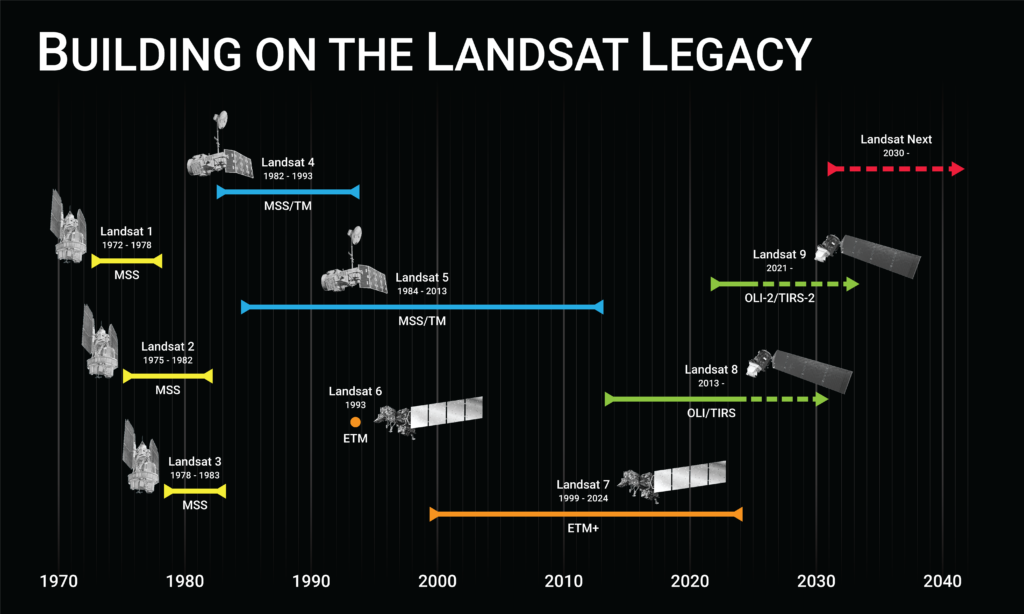
An Innovative Mission Concept
Landsat Next is an innovative mission concept that will continue the Landsat program’s legacy of global land imaging with greater temporal frequency, finer spatial resolution, and richer spectral information. The mission architecture reflects both advances in technology, in part through the NASA Sustainable Land Imaging-Technology (SLI-T) program, and user priorities for land monitoring, as reflected in the following key documents:
- User Needs for Future Landsat Missions (Wu et al., 2019)
- Recommendations for Possible Future U.S. Global Land Data Collection Missions Beyond Landsat 9 (Landsat Advisory Group, 2018)
- Landsat and Beyond (National Research Council, 2013)
- Recommendations from the 2018-2023 Landsat Science Team
- Feedback from the Landsat Next Request for Information (SAM.gov Notice ID: RFI2020lLandsatNext)
Landsat Next will consist of three identical satellite observatories, equally spaced in orbit. The entire constellation will be a Category 2, Class B mission with a 5-year design life, where each observatory will be composed of Class B and Class C systems. The instrument technical performance is not affected by the risk class designation, and the systems will include elements and mechanisms more typical of Class B instruments to ensure reliability, resiliency, and robustness. The key elements of the Landsat Next concept include:
Continuation of the Landsat legacy through sustainable mission operations.
Implementation of a constellation of three observatories with improved sensors to enhance reliability and systematic monitoring of the Earth.
Improvement of temporal revisit, with an aggregate 6-day repeat period, to increase cloud-free observation frequency.
Collection of bands with higher spatial resolutions, ranging from 10 to 60 meters, for improved detection, monitoring, and management.
Acquisition of 26 spectral bands to support Landsat data continuity,
Sentinel-2 compatibility, and emerging applications.
Preservation of spatial, geometric, and radiometric requirements to maintain long-term data consistency and ensure high-quality science products.
Collection of reflective and thermal infrared bands within 15 seconds of each other to allow for band-to-band georegistration and accurate observations.
Development of the Worldwide Reference System-3 (WRS-3) based on the updated orbital parameters.
Implementation of new techniques to increase the efficiency of ground system operations and improve the distribution of data products.
Video credit: NASA Scientific Visualization Studio, Goddard Space Flight Center.
More Frequent Observations
Improved temporal revisit was identified as the greatest priority by Landsat stakeholders and data users. At least weekly Landsat observations were desired to increase cloud-free image frequency and availability; enhance phenological observations and measurements; better understand landscape disturbance and recovery; advance monitoring and modeling of landscape dynamics; and support more effective mitigation strategies.
From the beginning of the Landsat program with Landsat 1 and Landsat 2 (1975-1978), near weekly revisit frequency was achievable using observations from two or more single observatory missions (except from 1993 to 1999 due to the launch failure of Landsat 6). This approach requires an observatory to perform beyond its design life and provide sufficient overlap with the following mission. Data harmonization and fusion are limited by shared heritage bands and the spatial resolutions of the overlapping observatories. For instance, Landsat 8 and Landsat 9 were separate missions, each with a 16-day repeat cycle and a 5-year mission design life. This pair of nearly identical observatories have an aggregate 8-day temporal revisit, but Landsat 9 was not launched until eight years after Landsat 8. In contrast to a single observatory mission cadence, Landsat Next will deploy three identical observatories, all at the same time.
Landsat Next will use advances in instrument and spacecraft technology to disaggregate the large, single satellite design of previous missions into a constellation of three identical observatories. The three observatories, which will be spaced 120 degrees apart in an 18-day temporal revisit, will provide an aggregate temporal revisit of 6 days at the equator. Revisit times at higher latitudes and in polar regions, where swaths have greater overlap, will be more frequent. Sub-weekly temporal revisit fulfills Landsat data user needs and will support a variety of emerging applications.
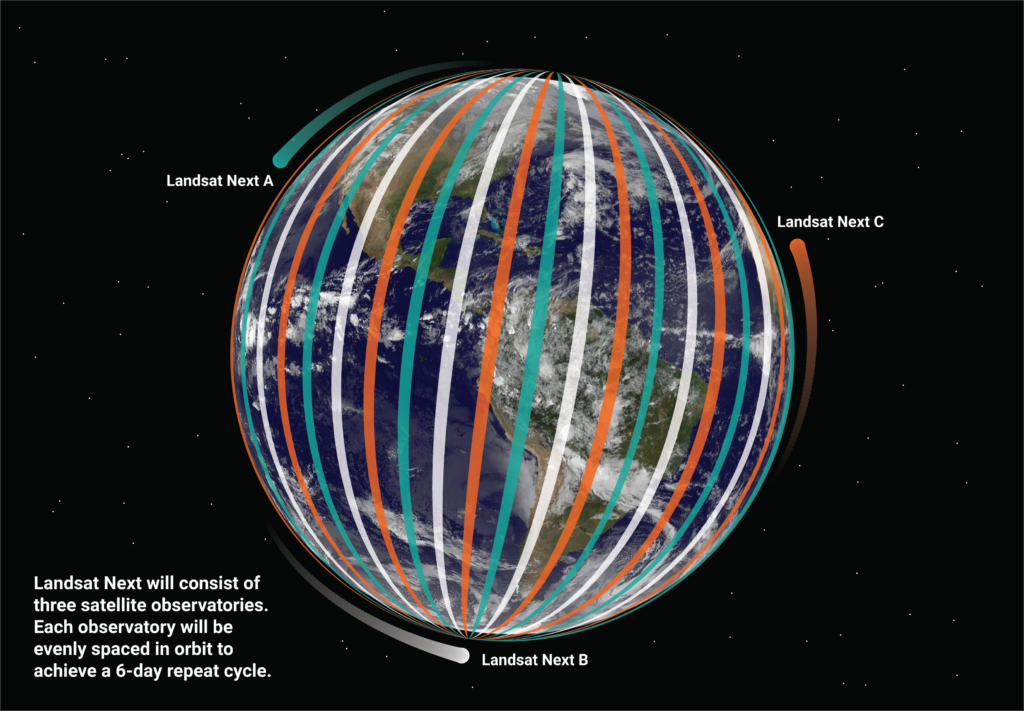
A New Worldwide Reference System
Each Landsat Next observatory will occupy a sun-synchronous orbit at an altitude of 653 kilometers (406 miles), have an inclination of ~98 degrees, and image the ground track at the equator at 10:10 am ± 5 minutes (mean local time at descending node). For a single observatory to achieve an 18-day temporal revisit based on the field-of-view requirements, a lower orbital altitude than previous Landsat satellites was required. Images, or scenes, acquired by the former Landsat missions were cataloged and referenced using previous Worldwide Reference System (WRS) grids (i.e., WRS-1 and WRS-2).
To accommodate the Landsat Next repeating ground track and global revisit cycle, a new global grid reference system called WRS-3 was established to acquire, catalog, and distribute Landsat Next scenes. Preserving the previous global reference system and heritage view angle geometry was considered less critical to the overall Landsat Next mission architecture, since science applications are increasingly moving from scene- to pixel-based analysis using BRDF-normalized data.
Under WRS-3, global acquisitions will be completed in 265 orbits (i.e., paths), compared to the 233 orbits associated with WRS-2. The orbits are numbered sequentially with path numbers increasing from east to west. The row indexing system will be the same as WRS-2, with the orbital paths being segmented into 248 equally scene centers based on lines of latitude, but the swath size will be slightly narrower. The rows are indexed so that the numbers of the descending (daytime) path increase in the along-track direction.
The number of unique ground tracks means that adjacent tracks are approximately 151 kilometers (94 miles) apart at the equator. Therefore, the minimum swath width, after adding 10 kilometers for ground track error and 3 kilometers for margin, is 164 kilometers (102 miles). The along-track scene length, which includes a combined 3% in-track overlap with adjacent scenes, is 168 kilometers (104 miles).
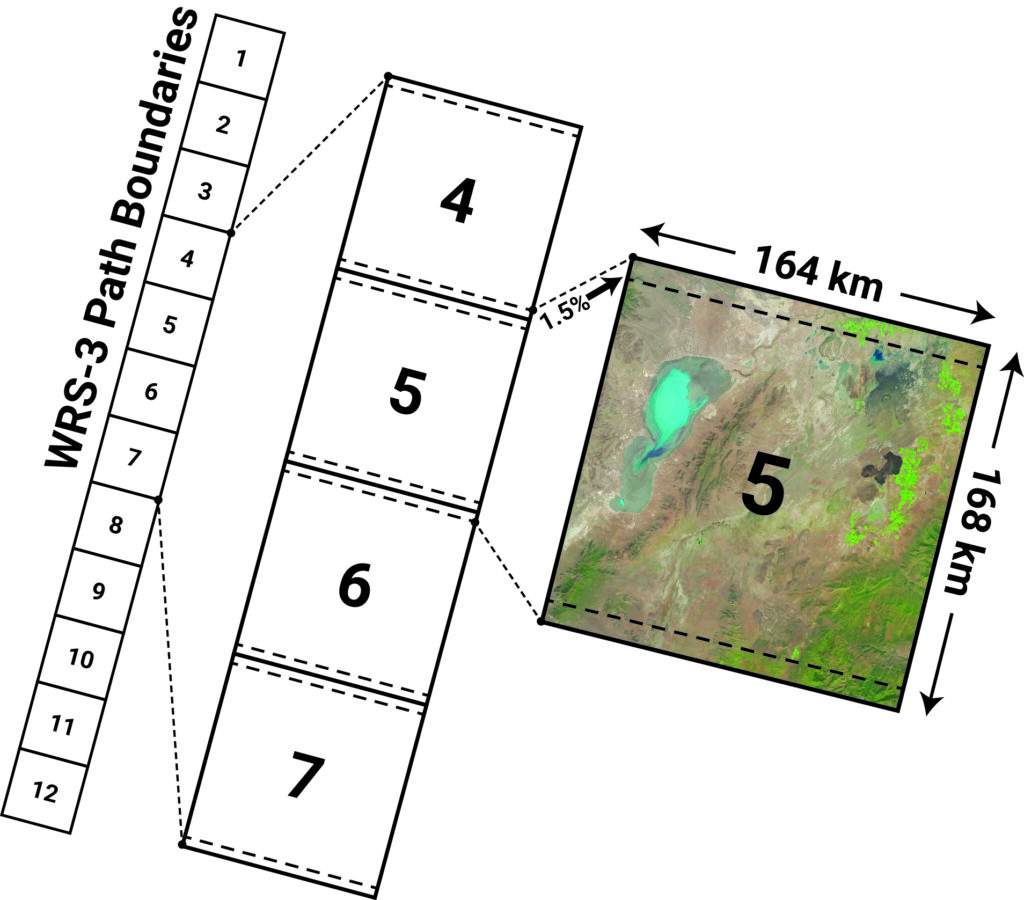
|
WRS-3 PARAMETER
|
VALUE
|
|---|---|
|
Equatorial Altitude
|
653 km
|
|
Inclination
|
97.9835 degrees
|
|
Mean Local Time (Descending Node)
|
10:10 am ± 5 minutes
|
|
Number of Paths
|
265
|
|
Number of Rows
|
248
|
|
Repeat Cycle
|
18 days
|
|
Descending Node Row
|
60
|
|
Longitude of Path 001, Row 060
|
-65.2 degrees (65.2 W)
|
|
Swath Width
|
164 km
|
|
Along-Track Scene Length
|
168 km
|
|
Scene Size
|
164 km x 168 km
|
Improved Spatial Resolutions
A user needs survey (Wu et al., 2019) revealed that Landsat reflective and thermal infrared emission band data could be better optimized and harmonized with Sentinel-2 data by increasing the spatial resolution of bands for future Landsat missions. Finer spatial resolutions better characterize surface features and dynamics, particularly in heterogenous landscapes with complex structural and compositional variability, such as those in urban environments and coastal ecosystems. They also facilitate the detection and mapping of smaller features, such as woodlots, streams, riparian corridors, and agricultural fields.
Landsat Next will collect all 26 spectral bands at improved spatial resolutions, with ground sample distances (GSD) of 10 to 20 meters for the VSWIR (visible to shortwave infrared) bands and 60 meters for the atmospheric and TIR (thermal infrared) bands. Five fundamental bands, including Red 2, Green, Blue, NIR Broad, and SWIR 1, will have a GSD of 10 meters. These bands will facilitate considerable advancements in land cover mapping and enable the calculation of spectral indices (e.g., NDVI, NDMI, MSAVI, SAVI, NDSI) with finer spatial resolutions.
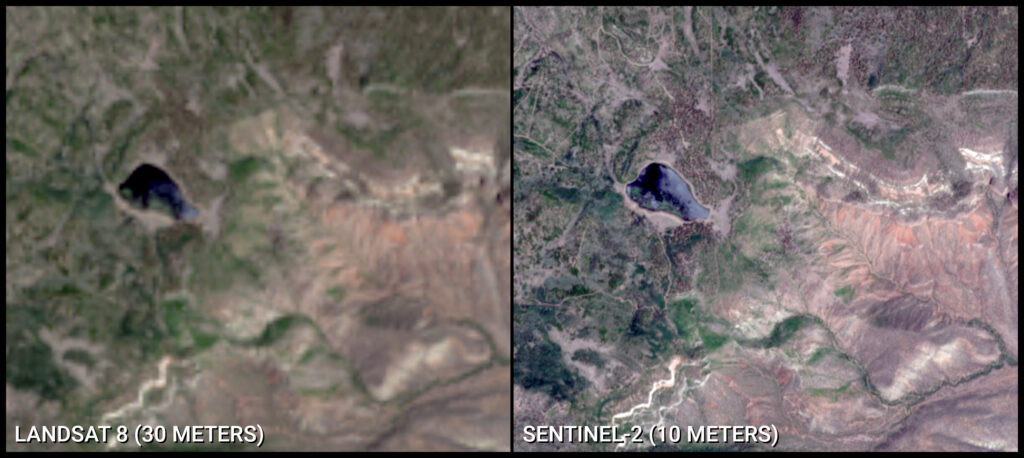
Enhanced Spectral Capabilities
Over the course of five decades, the number of spectral bands acquired by Landsat sensors has increased as technological advancements have been made. Landsat 1, with its Multispectral Scanner (MSS), collected four broad, visible and near infrared (NIR) bands. Landsat 8 and Landsat 9 each acquire 11 spectral bands with their Operational Land Imager (OLI/OLI-2) and Thermal Infrared Sensor (TIRS/TIRS-2) instruments. The addition of new bands, including thermal emission bands, with each successive generation of Landsat satellites has supported novel and emerging scientific applications and permitted a greater understanding of global ecosystems and processes, all while maintaining the long-term “heritage” bands to ensure consistency with data from earlier missions.
Landsat Next’s 26 superspectral bands reflect user needs for data continuity and new sources of Earth observation data to address emerging challenges in land, water, and climate science. These enhanced capabilities are made possible by recent advances in instruments, sensors, and observatory components. “Superspectral” refers to a greater number of bands than the previous multispectral Landsat missions. Similar to former Landsat missions, the bands were preselected by the user community based on science needs and previous laboratory, field, airborne, or space-based studies, and were carefully aligned to minimize absorption by the atmosphere (i.e., bands are located in “atmospheric windows“).
Landsat Next will acquire refined versions of the 11 Landsat “heritage” bands, which includes subdividing broad broads for emerging applications and adding TIR bands for temperature and emissivity separation. To support synergy and data fusion with Sentinel-2 data, five new bands with similar spatial and spectral characteristics were included. Ten new spectral bands were added to support evolving and emerging applications, including detection of harmful algal blooms (HABs); snow/ice grain size retrieval and monitoring of melt dynamics; and quantification of crop residue and non-photosynthetic vegetation for agricultural management and soil conservation. An infrared water vapor band was also added to retrieve total column water vapor and remove residual atmospheric absorption and scattering effects in Landsat image data without requiring ancillary data from other Earth observing satellites.
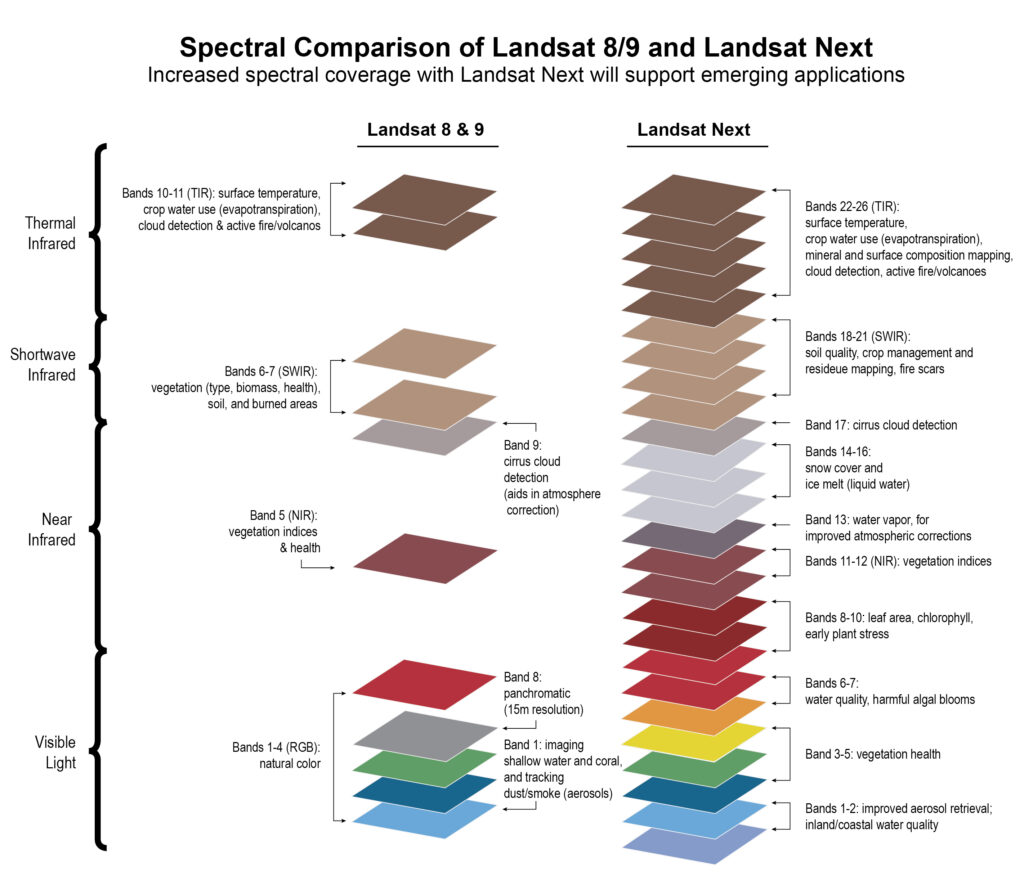
|
BANDS
|
GSD (m)
|
WAVELENGTH RANGE (nm)
|
RATIONALE
|
|
|---|---|---|---|---|
|
1
|
Violet
|
60
|
402 - 422
|
Aerosol retrieval, atmospheric correction, detection of colored dissolved organic matter
|
|
2
|
Coastal/Aerosol
|
20
|
433 - 453
|
Landsat heritage, Sentinel-2 synergy, vegetation health and plant vigor assessments
|
|
3
|
Blue
|
10
|
457.5 - 522.5
|
Landsat heritage, Sentinel-2 synergy, bathymetry, soil/vegetation mapping, detection of snow impurities
|
|
4
|
Green
|
10
|
542.5 - 577.5
|
Landsat heritage, Sentinel-2 synergy, vegetation health and plant vigor assessments
|
|
5
|
Yellow
|
20
|
585 - 615
|
Detection of leaf chlorosis and vegetation stress, aquatic health and water quality assessments
|
|
6
|
Orange
|
20
|
610 - 630
|
Phycocyanin (cyanobacteria) detection
|
|
7
|
Red 1
|
20
|
640 - 660
|
Landsat heritage, phycocyanin flourescence (cyanobacteria) detection, chlorophyll content mapping
|
|
8
|
Red 2
|
10
|
650 - 680
|
Landsat heritage, Sentinel-2 synergy, chlorophyll content and vegetation mapping, vegetation differentiation
|
|
9
|
Red Edge 1
|
20
|
697.5 - 712.5
|
Sentinel-2 synergy, leaf area index mapping, chlorophyll content and plant stress mapping
|
|
10
|
Red Edge 2
|
20
|
732.5 - 747.5
|
Sentinel-2 synergy, leaf area index mapping, chlorophyll content and plant stress mapping
|
|
11
|
NIR Broad
|
10
|
784.5 - 899.5
|
Sentinel-2 synergy, 10 meter NDVI, biomass content and shoreline detection
|
|
12
|
NIR 1
|
20
|
855 - 875
|
Landsat heritage, Sentinel-2 synergy, biomass content and shoreline detection
|
|
13
|
Water Vapor
|
60
|
935 - 955
|
Sentinel-2 synergy, atmospheric correction for land surface temperature, surface reflectance
|
|
14
|
Liquid Water
|
20
|
975 - 995
|
Liquid water and water surface state detection, vegetation water content mapping
|
|
15
|
Snow/Ice1
|
20
|
1025 - 1045
|
Snow grain size mapping
|
|
16
|
Snow/Ice 2
|
20
|
1080 - 1100
|
Ice absorption, snow grain size mapping
|
|
17
|
Cirrus
|
60
|
1360 - 1390
|
Landsat heritage, Sentinel-2 synergy, detection of cirrus (high-altitude) clouds
|
|
18
|
SWIR 1
|
10
|
1565 - 1655
|
Landsat heritage, Sentinel-2 synergy, detection of non-photosynthetic vegetation, fuel moisture mapping
|
|
19
|
SWIR 2a
|
20
|
2025.5 - 2050.5
|
Cellulose/crop residue mapping
|
|
20
|
SWIR 2b
|
20
|
2088 - 2128
|
Landsat heritage, cellulose/crop residue and soil moisture content mapping, fire scar detection
|
|
21
|
SWIR 2c
|
20
|
2191 - 2231
|
Landsat heritage, cellulose/crop residue and soil moisture content mapping, fire scar detection
|
|
22
|
TIR 1
|
60
|
8175 - 8425
|
ASTER synergy, mineral and surface composition mapping
|
|
23
|
TIR 2
|
60
|
8425 - 8775
|
ASTER synergy, emissivity separation, volcano/sulfur dioxide emissions mapping
|
|
24
|
TIR 3
|
60
|
8925 - 9275
|
ASTER synergy, mineral and surface composition mapping
|
|
25
|
TIR 4
|
60
|
11025 - 11575
|
Landsat heritage, surface temperature retrieval, carbonate mineral mapping
|
|
26
|
TIR 5
|
60
|
11725 - 12275
|
Landsat heritage, surface temperature retrieval, snow grain size and moisture content mapping
|
Robust Radiometric and Geometric Performance
The Landsat program has an extensive historical record of highly calibrated data and has served as a gold standard of global land imaging for more than five decades. These elevated standards have permitted time-series analyses and quantitative assessments; enabled the development of higher-level science products; and supported commercial and international sectors through cross-sensor calibration. Rigorous calibration and correction methods have also been applied to provide consistency to a time series that was acquired through different atmospheric conditions using eight different instruments with slightly different spatial, spectral, and view angle characteristics.


The Landsat Next mission will continue the vision of calibration and validation associated with the Landsat program. Radiometric requirements will be aligned with Landsat 8 and Landsat 9 heritage bands, and georegistration requirements will be adjusted to match the finer GSD of Landsat Next bands.
The radiometric requirements for Landsat Next include:
- Signal-to-noise ratios (SNR) matching Landsat 9 when aggregated to 30-meter pixels
- <5% absolute error in at-sensor radiance; <3% in reflectance
- TIR absolute radiometric accuracy 1% at normal Earth temperatures
- <1% VSWIR radiometric change during any WRS-3 cycle (<2% TIR)
The geometric requirements for Landsat Next include:
- Sub-pixel accuracy in band-to-band registration to support multispectral analysis
- <30 meter absolute geodetic error (CE90) before ground control
- <8 meter geometric error (CE90) after ground control and terrain compensation
To ensure band-to-band alignment and allow accurate cloud screening and science data product generation, each Landsat Next Instrument Suite (LandIS) will acquire all bands for a scene within a 15-second period. Band-to-band co-registration will be 2, 3, and 6 meters for the 10-, 20-, and 60-meter solar reflective bands, respectively, and 15 meters between the reflective and TIR bands.
Data Volumes, Storage, and Computing
Landsat Next, with its three observatories, will acquire significantly more data than prior Landsat missions. In terms of scene acquisitions, the triplet observatories will collect an estimated 2,220 scenes per day. With each scene measuring 164 kilometers by 168 kilometers, this equates to the daily acquisition of roughly 60 million square kilometers or an area comparable to two African continents.
Landsat Next will obtain approximately 10 times more data volume than either Landsat 8 or Landsat 9. Compressed Level-1 Landsat Next data products, assuming 14-bit depth for reflective bands and 12-bit depth for thermal bands, are currently estimated to be 3.7 gigabytes per scene. Given that the three observatories will acquire 2,220 scenes each day, greater than 8.2 terabytes of data will be added to the Landsat archive on a daily basis. This is equivalent to 33 250-gigabyte hard drives or 128 64-gigabyte cell phones. Every four months in operation, Landsat Next will contribute an additional petabyte of data to the archive.
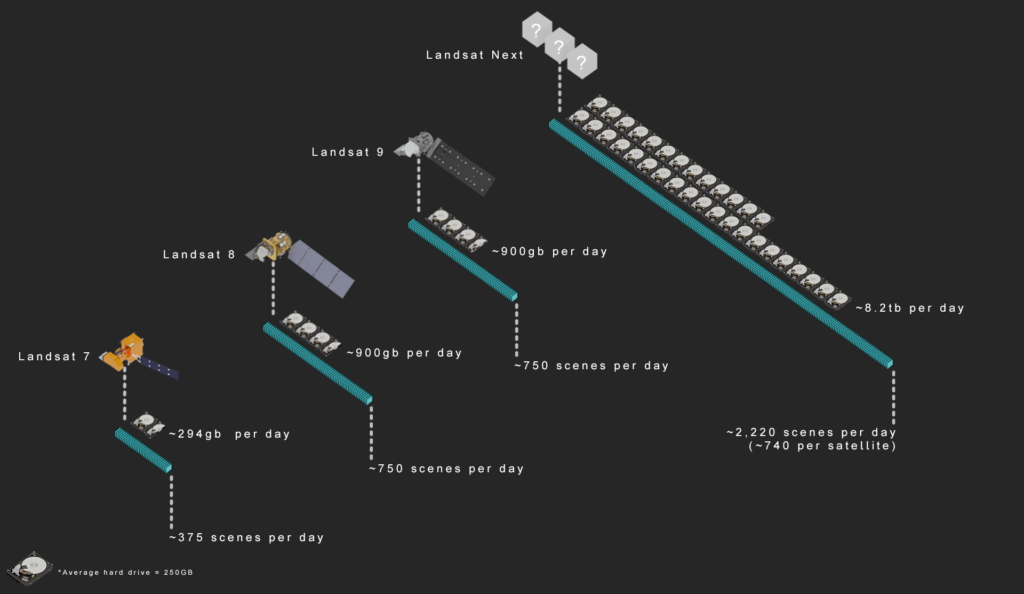
The growing volume of data highlights the need to implement new and improved techniques to simplify the management and distribution of data and science products. Cloud storage and computing platforms have and will enable Landsat data to be stored, managed, and analyzed in a cost-effective, scalable, secure, and reliable manner. These services effectively address the challenges of big data storage, facilitate geoprocessing and analysis of large areas over long periods of time, and provide opportunities to explore the growing record of Landsat observations.

